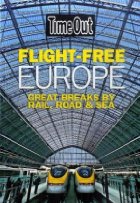 Flight-Free Europe is yet another fantastic travel guide from Time Out. Just as the title says, this guide gives you the low-down on how to get about Europe without setting foot in an airport. Whether you choose train, coach or ferry; are looking for a weekend break or a long journey; are into bars and nightlife of culture and gentle pursuits (or both!): this book has something for you. There are suggestions especially for families, but of of course most families out and about can can read a ‘generic’ travel guide and know what is, and isn’t, going to work for their tribe.
Flight-Free Europe is yet another fantastic travel guide from Time Out. Just as the title says, this guide gives you the low-down on how to get about Europe without setting foot in an airport. Whether you choose train, coach or ferry; are looking for a weekend break or a long journey; are into bars and nightlife of culture and gentle pursuits (or both!): this book has something for you. There are suggestions especially for families, but of of course most families out and about can can read a ‘generic’ travel guide and know what is, and isn’t, going to work for their tribe.
The book is organised in three main sections. The first is dedicated to ‘hubs’ – the main train stations you will travel to and/or through if you are taking the train from St Pancras in London: Paris, Brussels, Lille and Cologne. Each of these not only gets a decent write up—what to see, suggestions on where to stay and eat—but also a short section on what other destinations mean you are likely to come to this ‘hub’ in the first place. The next section is ‘destinations’—places that you could easily reach from the United Kingdom without resorting to flying. The last sections is ‘journeys’, which is dedicated to longer or famous trips such as the Orient Express, travelling to Morocco or the Polar Circle. As is the case for ‘hubs’, these two sections are full of information on how to get there, what to do, and there are many web addresses included.
What is most impressive about this guide, however, is that it is written and published by Time Out. As they themselves say in the introduction:
Over several years, Time Out produced a number of publications with titles such as Fly Europe and Europe by Air. The rise of the low-cost airline was a catalyst for these and reflected the public need for short, sharp city guides.
A new demand for inspirational, environmentally aware travel ideas prompted the present book.
Okay, so it is not exactly a mea culpa for being a contributor to the British obsession with ‘weekend breaks’ including cheap air-tickets, but it is good of them to at least acknowledge this is a break with their past philosophy. And what is also enjoyable is that while the destinations and means of getting there have ‘green’ ratings, and the book does include information on how different modes of transport are less environmentally damaging than air travel, the main emphasis is on non-air travel being fun, adventurous and often more convenient and stress free. Or in other words, preferable to flying not only because it is better in a ‘green’ sense, but just because it is better, full stop.



